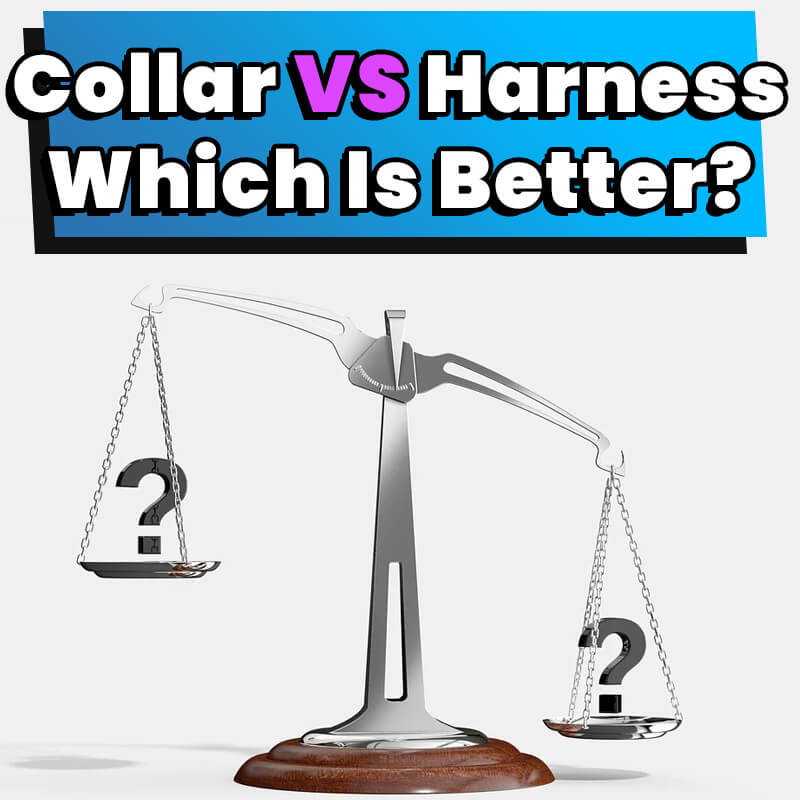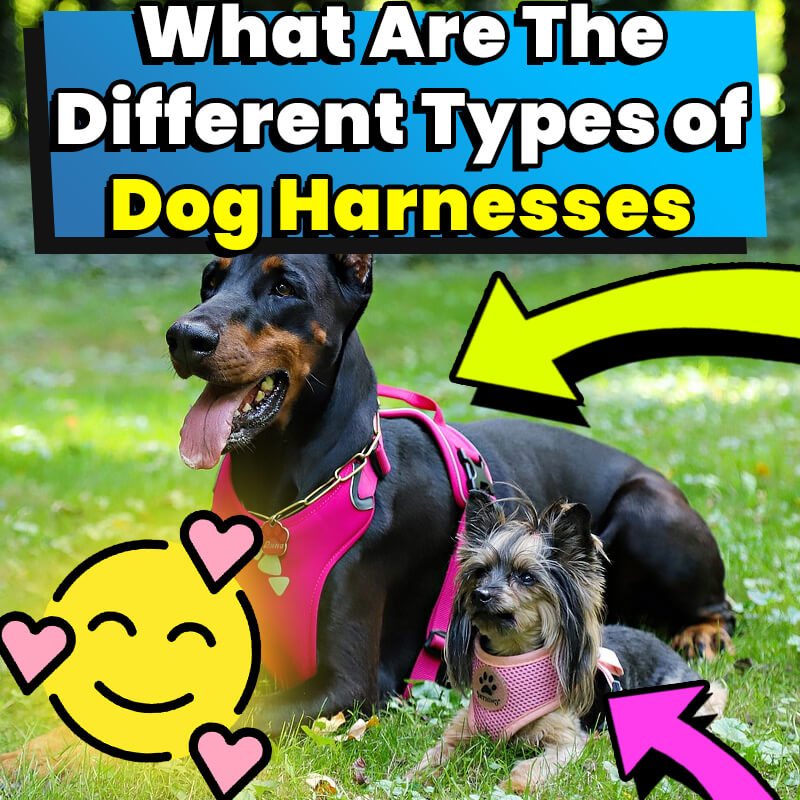The main difference between collar and harness is that collar is a convenient way to securely keep rabies and identification tag on your dogs at all times, whether on or off-leash while the harness is generally worn during leashed walks and gives the owner greater control while discouraging the dogs from pulling. The harness disperses pressure over a large area of the dog’s body instead of just the neck area.

On your daily walks with your well-behaved pooch, you’ve probably noticed more and more dogs wearing harnesses rather than collars. Your dog is wearing a collar with a retractable dog leash attached to it and you’re wondering if harnesses may be safer for them than collars.
If you’re wondering any of the following questions, you’ve come to the right article.
- Is a Dog Harness Better Than a Collar?
- Should my dog wear a collar or harness?
- Can my dog wear a harness instead of a collar? Which one is right?
Harness vs. Collar: Which is better? Whether a dog collar or a dog harness is better really depends on your preferences and your dog’s leash walking etiquette and behavior. In some cases, a collar may be best while in other cases, a harness is better. We recommend having both. If you’re looking to effectively train your dog, both a collar and a harness are needed.
While taking your furry friends out for daily walks, you’ve probably noticed one of the following behaviors.
- At one point or another during your walks, your pups may tug the leash pretty hard.
- Your canine companions may pull against the tension while he is wearing a collar.
Both of these behaviors may cause you to worry about them choking. Due to this, you may be thinking about getting a harness for them. Before you ditch that collar altogether, let’s go over the pros and cons of both the collar and the harness. This will help you decide which is option is best for you and your pooch.
Handy Hint: Before you go out and buy a harness for your pooch, be sure to read up on the different types of dog harnesses since there are four types and you want to buy the right one for your pooch.
Table of Contents
Advantages And Disadvantages of Collars and Harnesses
COLLARS

Let’s discuss the pros and cons of the dog collar first.
Pros
- Collars are a comfortable and convenient way to securely keep identification and rabies tags on your pooch at all times.
- Many dogs do not notice that they’re wearing a simple flat-buckle collar or snap collar whether they’re on or off-leash.
- There is a wide variety of collar types and materials. Each type of dog collar serves specific needs and purposes.
- For example, slip collars are great for puppies that are prone to slipping out of traditional collars. They are designed to close around the neck when puppies pull or back up without choking.
- Slip collars are great for greyhounds, bulldogs, and other dog breeds that have slim heads or thick necks.
- A dog collar that is convenient for everyday use is the flat collar.
- Another great collar is the breakaway collar. It detaches or releases under pressure.
- Break away collar eliminates the risk of suffocation in an accident. It’s great for dogs that like to chase squirrels because it will release under pressure to prevent accidental hanging if dogs accidentally get caught on the fence.
Cons
- If you have broad-necked or small-headed dogs, it is effortless for them to slip out or duck out of their collars.
- Collars may not fit properly on super tiny dogs like a Chihuahua.
- Avoid dog collars if your furry friend likes to pull or has a habit of pulling. Collars are known to cause thyroid and/or trachea damage to dogs that pull.
- If your canine friends get into a dog fight or are roughhousing in the backyard or park, it’s possible for the collars to get caught in the jaws of other dogs.
- Even during normal play, the collar may get caught on objects and this may lead to injury or suffocation.
- For certain dog breeds, if too much pressure is applied to their neck when wearing the collar, it can cause their eyeballs to protrude from their sockets.
How tight should a dog collar be?
A dog collar should not be too tight or too loose. To fit the collar just right on your pooch’s neck, you’ll need to use the Two Finger Rule. With your index and middle fingers, you’ll want to slide them in between your pup’s collar and their neck.
If your two fingers are able to slide in between the collar and the neck easily and are snug, then the dog collar fits just right.
The collar is way too tight on your furry friend’s neck if your two fingers are not able to slide in easily and you have to apply a bit of force.
A dog collar that is too loose can have negative consequences. If you slide both your fingers through the collar and neck and it doesn’t feel snug, then it is loose.
Some owners prefer that their pooch wear the collar at all times because it carries their dog’s identification information and rabies tag. In this case, make sure to routinely check that the collar is a good fit at all times.
HARNESSES

Pros
- If your pooch wears the harness during leashed walks, there is less pull-stress on both the dog and the owner.
- While you are walking strong or very large dogs, harnesses give the owners much better control. Also, it is easier on the owners’ arms and back.
- A dog harness is a good training tool for puppies that haven’t learned to walk on a lead yet.
- Dog harnesses can prevent puppies from getting tangled up in the leash and potentially getting hurt in the process.
- Harnesses are designed to discourage pulling. For example, front-clip harnesses have proved to be effective when training dogs or puppies not to pull on the leash while walking.
- If your canine friends pull on the leash while wearing collars, they will move forward. This makes them think the pulling is successful. Harnesses, whether attached to the dogs’ chest or between the shoulder blades, will redirect the dog. This way, there is no reward for pulling because doing so will not get them anywhere.
- Harnesses come in a greater variety of sizes than collars.
- Harnesses may be a better option for extra-small or extra-large dogs.
- Do you have dogs that like to chase squirrels or birds? If you’re afraid they may accidentally get caught on the fence, then wearing the harness prevents your furry friend from hanging or suffocating.
- On busy or crowded streets, harnesses offer better control.
- A harness disperses the pressure over a larger area of the dogs’ body and minimizes injury from pulling or tugging on the leash. This makes it safe for small and large dogs alike.
- Wearing a harness helps to prevent the risk of neck injuries by reducing the strain on your furry friend’s necks and backs.
- Sometimes dogs may need a little assistance standing after sitting or lying down for a while. The harness can help pull dogs up gently without causing any pain or discomfort.
- Harnesses are a great solution for canines that can easily escape from their collars due to their head or neck size.
- Dog breeds like Pugs or French Bulldogs would benefit from wearing harnesses instead of dog collars because they are prone to respiratory problems and tracheal collapse. Harnesses are less restricting than collars.
- If you’re taking your four-legged friends hiking or biking with you, wearing a harness is a great option over collars.
Cons
- When your pooch is indoors or playing with other dogs, it’s best to always remove the harnesses.
- Harnesses aren’t comfortable for all-day use.
- There’s a possibility of getting skin chafing around the elbows when dogs wear the harness excessively.
- If harnesses are not fitted properly and correctly, they can cause serious discomfort, inhibit the dogs’ movement and alter their natural gait.
- Dogs with long coat may get their hair caught up in the harness.
READ NEXT: What To Put On Rope Burn From Dog Leash?
Can you still use a retractable dog leash for both?
If you’re a dog owner who prefers to use a retractable dog leash, the good news is that you can still use it no matter if your pooch is wearing a collar or a harness. The traditional standard dog harness has a leash attachment D ring on top of the dog’s back near the shoulder area. The D ring allows you to clip the retractable dog leash onto it.
Conclusion
Whether your dog is wearing a collar or a harness, always make sure he is wearing the identification and rabies tags at all times. You never know when something unexpected frightens or distracts your dog and causes him to bolt from your house or bolt from your control.
If you worry that your canine friends will escape from your backyard, you’ll want to install a wireless dog fence around your premises. Always make sure that whichever one he wears, that he is comfortable in it.
We believe both collars and harnesses are essential to your dog’s health and safety. Whether the dog harness is is better than the collar depends on the dogs’ breed, size, health as well as daily activities.
Based on the advantages and disadvantages of collars and harnesses above, we recommend dog harness for your pooch. Although collars are effective in restraining your furry friends, harnesses are often more comfortable for dogs of different sizes and breeds.
The harness also distributes the pressure is evenly throughout your furry friend’s body instead of just their neck. Harnesses provide both the dog and their owners the protection from pull stress and the dog owners now have better control without any pressure to their arm or back.

With over five years of specialized experience as an animal writer, my expertise lies in dog nutrition, health, behavior, grooming, and training. I am dedicated to delivering helpful and informative content that caters to the well-being of our furry friends. My primary goal is to empower pet owners with knowledge and ensure our canine companions thrive in health and happiness. In my free time, I love volunteering at local dog rescue centers.






